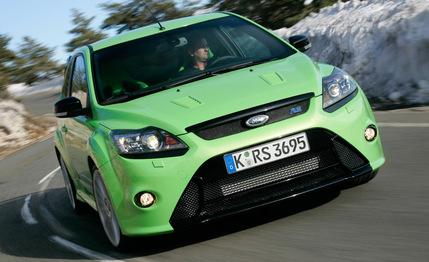 First Drive Review
First Drive Review

The Ford Focus RS is the world’s best hot hatchback. A sweeping statement, to be sure, but if you look at Car and Driver’s favorites among these sporty but practical small cars—the Mazdaspeed 3 and the Volkswagen GTI—the latest and greatest Focus beats them in all respects. Except one: You can’t buy it here. Yet.
Forbidden Fruit
This car, developed in Germany by Ford Team RS (for Rallye Sport), is yet another example of the driving excellence of Ford’s European products, several of which will find their way into the American market in two or three years. And when the U.S. gets back in sync with Europe on the next-generation Focus in 2011—the current U.S. Focus rides on the first-generation platform versus the third-gen version currently sold in Europe—there is a desire at Ford to include an RS version in the lineup.
There are many reasons why the Focus RS succeeds in Europe. It has 300 horsepower—more than any other front-wheel-drive car available. Its front suspension has been comprehensively revised to all but eliminate torque steer. A mechanical limited-slip differential from race-car-transmission specialists Quaife aids in its remarkable cornering ability. And it costs less than other cars with comparable performance.
The price demands some explanation. In the U.K., the RS was priced at £24,995 (about $34,500) when it went on sale in March. That price sounds steep but includes a 17.5-percent value-added tax. The RS would likely cost about $28,000 if sold in the U.S.
Sounds good? You bet. Flat-out on the autobahn, the Focus RS will do a claimed 163 mph, and based on power to weight, we think it will run high-13s in the quarter-mile. But the figures do not prepare you for the smooth, comfortable way it copes with slow running as well as winding roads.
A Real Hot Hatch
The engine, a turbocharged 2.5-liter five-cylinder that started life at Volvo, has a splendid spread of torque—325 lb-ft from 2300 to 4500 rpm. Compared with the 223-hp Focus ST, also powered by the 2.5-liter five, the RS has an aluminum cylinder block with metal-sprayed bores instead of cast-in liners; different pistons, rods, and cams; and a larger BorgWarner K16 turbo.

A strengthened six-speed manual is the only transmission. The Quaife torque-biasing helical differential is actually very similar to that used in the first-generation Focus RS, which was an unruly car on anything other than a smooth racetrack. (Clearly, that was not the differential’s fault, as the new RS has only the slightest hint of torque steer, a tiny tug at the wheel to remind you just how much power it is delivering to the front wheels.)
Revolutionary Knuckles
The secret of good behavior for the new RS is its front suspension. The Focus’s standard MacPherson-strut arrangement has been augmented by a two-piece lower link that Ford calls “Revo-Knuckle.” This configuration moves the steering axis outward to reduce its distance from the center of the contact patch (called kingpin offset or scrub radius), which helps to minimize the torque-steer effect. This dictated a 1.6-inch-wider track (and wider bodywork to suit). The result is great traction along with precise, predictable handling, excellent body control, and a ride that is firm but entirely reasonable for a car of this potential.
The RS’s lurid colors and shiny black add-on spoilers, scoops, and grilles are not universally admired. But the way this car goes about its business certainly is. It is the fastest Ford this side of the GT supercar. We hope it bodes well for this car’s American aspirations that the boss of Team RS, Jost Capito, now has worldwide responsibility for Ford’s performance vehicles.